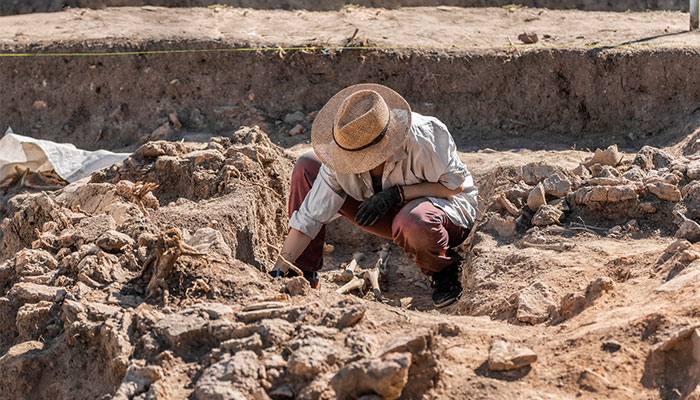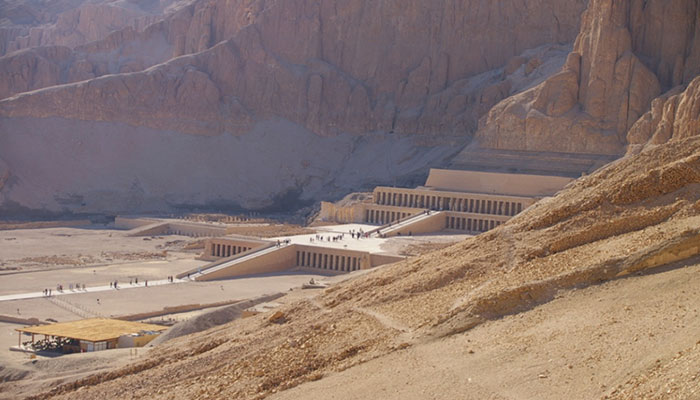The tomb of Thutmose II was found this month in a remote location two kilometres from the Valley of the Kings, where most of the New Kingdom pharaohs are buried (circa 1550-1069 BC). It’s the first royal tomb of the 18th Dynasty to be discovered since 1922.

For over a century, research has centred on the Valley of the Kings, but not all of the kings were buried there. More recently, archaeologists have worked in other areas, particularly desert valleys in the vicinity. The tomb of Thutmose II was found in one such area. These tombs are not easily found: the terrain is harsh and covered with rock-fall and flood debris. Draʻ Abu el-Naga' in the Theban Necropolis is another known royal burial ground, where the Macquarie Theban Tombs Project has worked for 35 years on tombs of the New Kingdom elite.
King Thutmose II's tomb has proven somewhat disappointing for the excavators as it was largely empty, except for fragmentary decoration on the walls and ceiling, pieces of an inscribed stone vessel with his name and that of his wife, the famous Hatshepsut. She likely buried him.
Excavation takes place - including in Australia - for cultural heritage reasons: site protection and preservation from expanding towns and roads.
The team believes there is another tomb containing the objects but this remains to be seen. Many royal mummies were removed from their tombs by Egyptian officials around 3000 years ago and secretly re-buried for protection. A large cache near Hatshepsut's famous temple was discovered by Egyptologists in 1881 which included the possible mummy of Thutmose II. Perhaps his tomb was cleaned out by ancient officials and the objects re-purposed by other rulers, a known fate of many royal artefacts?
Who was King Thutmose II?
King Thutmose is a shadowy figure owing to a short-ish reign, estimated to be around fourteen years. He was the son of Thutmose I, one of the great kings of the 18th Dynasty from 3500 years ago.
Thutmose II married his half-sister Hatshepsut, who, after her husband’s early death, eventually crowned herself pharaoh to rule alongside her stepson, Thutmose III.
From the ancient sources, there were two major events during the reign of Thutmose II. He dispatched his army into Nubia, (southern Egypt/northern Sudan), and had a campaign in the Sinai against the desert Bedouin.

Desert treasure: Mortuary Temple of Hatshepsut, Deir el-Bahari, Egypt. Image credit: Dr Karin Sowada
Archaeologists know where to start digging because there are usually clues around where rock-cut tombs are located. Tool marks or quarrying of the rock face shows archaeologists that humans have modified the landscape; in addition there might be ancient graffiti.
When looking for a new site, archaeologists survey an area, consult ancient and modern sources and often talk to the locals. Other sites may be visible if there are built remains or other materials, like pottery, on the surface. Geophysical prospecting is also used to detect new archaeological sites without disturbing the ground.
- What you'll discover at the new Pompeii exhibition: review
- Gladiator II: How historically accurate is it?
A great deal of excavation takes place - including in Australia - for cultural heritage reasons: site protection, preservation from expanding towns and roads. In Egypt, excavation and conservation by the Egyptian Supreme Council of Antiquities and international institutions helps preserve the precious cultural heritage of this amazing country.
The Macquarie Australian Centre for Egyptology is privileged to have been part of these efforts for 45 years, most recently with the Theban Tombs Project, Beni Hassan Project and new work at Giza.
Dr Karin Sowada is Director of the Australian Centre for Egyptology and a senior lecturer in the Faculty of Arts, Macquarie University.



